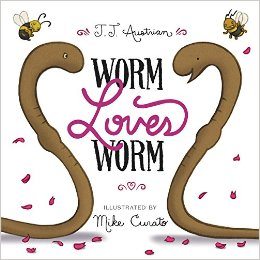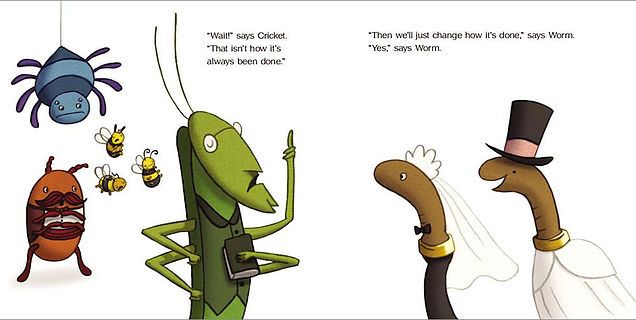 I finally had a chance to read one of my new favorite picture books—Worm Loves Worm by J.J. Austrian, illustrated by Mike Curato — to a group of kids. It was Valentine’s Day — the kids were making valentines, learning origami, and listening to love stories read by moi.
I finally had a chance to read one of my new favorite picture books—Worm Loves Worm by J.J. Austrian, illustrated by Mike Curato — to a group of kids. It was Valentine’s Day — the kids were making valentines, learning origami, and listening to love stories read by moi.
My mistake was trying to call them away from the origami and stickers and scraps by saying: Hey kids! Let’s read some love stories!
A couple of them looked up and made a face, but most ignored me. The adults came to my aid and tried to get everyone to circle up, but the assurances that everyone could go back to their crafting did little to persuade. They’re readers, but they’re also crafters. Unfair to make them choose, but I did. I announced grandly, “The first book is about worms….”
That got their attention.
“Worms?” they said.
“I thought you said you were reading love stories,” said one child (who will be a lawyer some day.)
“Yes,” I said. “This is a love story. About worms.”
A few left their scraps and stickers and came over to see. I started the story.
Worm loves Worm.
“Let’s be married,” says Worm to Worm.
“Yes!” answers Worm.
“Let’s be married.”
“I didn’t know worms could get married!” said one child. More joined our circle.
I turned the page. Worm and Worm’s friend Cricket volunteers to marry them, because you have to have someone to marry you — “that’s how it’s always been done.”
That’s How It’s Always Been Done is a major refrain in this book.
“Now can we be married?” asks Worm.
But no, not yet. Beetle insists on a best beetle, and volunteers himself for the role. The Bees insist on being bride’s bees. And then there are the rings to consider — because, of course, “that’s how it’s always been done.”
It goes on and on — the usual trapping of a wedding, the ways “it’s always been done” — are trotted out as hurdles, if not quite objections. Patiently the worms adapt. Their friends see how things can be different. They’ll wear the rings like belts, not having fingers. They’ll do The Worm at the dance, not having feet to dance with. Their friend Spider will attach the hat and flowers with sticky web and eat the cake “along with Cricket and Beetle,” since worms do not eat cake.
Now, the adults in the room understood the story as a clever way to turn the same-gender vs. different-gender marriage debate upside down. They were delighted. These are parents who have raised their kids to support marriage for all — indeed, some of the kids in my audience are being raised in a family with two moms/dads.
The kids understood the more subtle message behind the story, though. It’s about change. It’s about learning to see past How It’s Always Been Done. They didn’t even blink when one worm wore a veil and tux and the other wore a dress and top hat. This is how kids play dress up, after all. Details do not stymie children the way they do adults.
 0797
0797
The ending to this book is happy. When Cricket objects that “That isn’t how it’s always been done.” Worm says, “Then we’ll just change how it’s done.” The other worm said, “Yes.”
And the children said, “Yes.” And then they went back to their Valentines.

Kids are often wiser than we are, aren’t they? Thank you, Melanie, for sharing this book with your students. I wish I had heard this book when I was growing up.
Yes, David – kids are often wiser. I’m glad this one is joining a developing canon.